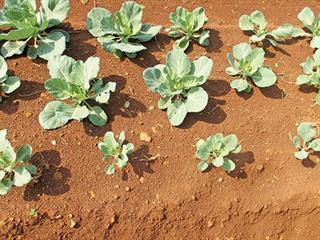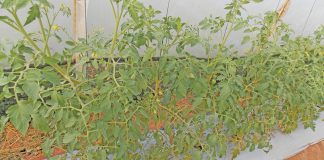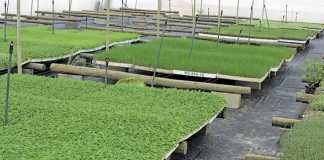
A treatment that I strongly recommend is to drench the cabbage seedlings with a nitrogen solution before planting. All the roots of a seedling are contained in the plug of growing medium. At planting, the bottom of the plug is likely to be 5cm below the soil surface. The growing medium itself is rather loose and coarse compared with the soil, and this density difference effectively creates a barrier between the medium and the soil.
A porous substance such as soil, a cloth or a sponge absorbs water naturally in a process called capillary action. The water moves because of an attraction beween the liquid and the solid surfaces.The forces are strong enough to defy gravity. To see how it works, take compact, wet soil and till the surface of a section. A short time later, you will find that the loose, tilled section is dry. Scrape this away, and you will see that the hard soil underneath is wet; water has passed through by capillary action.
By loosening the upper layer, you have now created a gap in the structure of the soil that prevents further movement of water.
This is exactly what happens where the plug and the soil are of different textures. The moisture will move up to the plug but not enter it. The result is that the plant could die through lack of water in moist soil. This is why you have to irrigate lightly at sufficient frequencies, replenishing the moisture in the plug from above. As soon as new roots move from the plug into the soil, you can relax this irrigation regime.
When to apply nitrogen
Nitrate nitrogen moves freely with water, and frequent light irrigations will move the nitrate deeper to below the 5cm point at the bottom of the plug. This creates a shortage of the element in the root zone, whereas there may be sufficient a little further down. If there is insufficient nitrogen, the plant will not grow leaves or roots. This is why it is so important to apply LAN to the plants just before planting.
Dissolve one handful of LAN (about 50g) in 8l to 10l of water in a watering can and irrigate 2 000 to 2 400 plants with it. By doing so, you will be supplying readily available nitrate, which will immediately be taken up, while the ammonia half will become available later. This ensures that everything is in place for a fast, uniform start.
Why lan produces better results
Commercial products are sold for this express purpose, but they do not work nearly as well as LAN. The label will show that the product contains several elements – your assurance that it has everything necessary for quick growth. Remember that it is just the nitrogen that leaches away and needs replacement. The other elements have already been supplied in the nursery and have enabled the plant to grow properly.
To understand this better, look at the photograph above. This land is far from the farmer’s sheds. The farmer ran out of LAN and planted without the treatment. The difference in growth between the upper and lower rows persisted up to harvest. Although this particular experiment was unintended, farmers should do such trials with their crops even if it is just to confirm what they already believe.
Tackle the insects at the same time
While fertilising seedlings, one can apply insecticide at the same time. I would recommend Imidaclorprid, which is available under various trade names. It is registered as a drench for control of aphids, which can be a serious problem when winter approaches.













